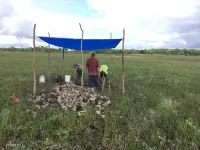(Press-News.org) DURHAM, N.H.—(November 22, 2024)—An archaeologist from the University of New Hampshire and her team have collected data which indicates the presence of a large-scale pre-Columbian fish-trapping facility. Discovered in the Crooked Tree Wildlife Sanctuary (CTWS), the largest inland wetland in Belize, the team dated the construction of these fisheries to the Late Archaic period (cal. 2000-1900 BCE), pre-dating Amazonian examples by a thousand years or more.
“The network of canals was designed to channel annual flood waters into source ponds for fish trapping and would have yielded enough fish to feed as many as 15,000 people year-round, conservatively,” said Eleanor Harrison-Buck, professor of anthropology and director of the Belize River East Archaeology (BREA) project. “The dates indicate that the fisheries were initially constructed by Late Archaic hunter-gatherer-fishers and continued to be used by their Formative Maya descendants (approximately 2000 BCE to 200 CE). For Mesoamerica in general, we tend to regard agricultural production as the engine of civilization, but this study tells us that it wasn’t just agriculture—it was also potential mass harvesting of aquatic species.”
Published in the journal Science Advances, the research used 26 radiocarbon dates from test excavation sites in the CTWS, which indicate that such landscape-scale wetland enhancements may have been an adaptive response to long-term climate disturbance recorded in Mesoamerica between 2200 and 1900 BCE.
“The early dates for the canals surprised us initially because we all assumed these massive constructions were built by the ancient Maya living in the nearby city centers,” said Harrison-Buck. “However, after running numerous radiocarbon dates, it became clear they were built much earlier.”
Sediment samples were collected along the walls of the excavation units and sequenced for specific elements, such as nitrogen and carbon, to look for environmental changes over time. The sediment showed a strong tropical forest dominance during that period and no evidence of crop cultivation, specifically maize. Along with a lack of any pollen from domesticated crops, there were not any signs of ditched and drained agricultural fields in the immediate area dating to that time. The multiproxy data gathered suggests the distinctive long linear zigzag channels served primarily as large-scale fish-trapping facilities.
“It seems likely that the canals allowed for annual fish harvests and social gatherings, which would have encouraged people to return to this area year after year and congregate for longer periods of time,” said Marieka Brouwer Burg, professor of anthropology at the University of Vermont and BREA co-director. “Such intensive investments in the landscape may have led ultimately to the development of the complex society characteristic of the pre-Columbian Maya civilization, which subsequently occurred in this area by around 1200 BCE.”
“Wetlands have always been a critical ecosystem for humans across the globe,” said Samantha Krause, professor of geography and environmental studies at Texas State University. “Knowing how to manage wetland resources responsibly is essential for the continued resilience of these ecosystems both in the past and today. The Archaic hunter-gatherer-fishers knew how to protect their resources and use them in a way that could sustain these habitats, not exhaust them, which explains their long-lasting occupation in this area.”
With the support of the local community, the team plans to return to Crooked Tree to investigate a larger sample of these landscape-scale modifications that they have identified across a broad area of northern Belize, hoping to more fully understand the complexity of human-wetland interactions in the past.
Other co-authors include Mark Willis, department of archaeology, Flinders University, Adelaide, South Australia; Angelina Perrotti, Palynology & Environmental Archaeology Research Lab; Monona, Wisconsin; and Katie Bailey, department of anthropology, University of Vermont.
This research was funded by a grant from the Alphawood Foundation Chicago. Additional support was provided by a collaborative research grant from the National Science Foundation. The Belize Institute of Archaeology provided an archaeological permit, granting permission to excavate in the Crooked Tree Wildlife Sanctuary. The Crooked Tree Village Council welcomed the research team and permitted them to map and excavate in the wetlands around their community.
PHOTOS FOR DOWNLOAD
https://www.unh.edu/unhtoday/sites/default/files/harrisonbuck_wetlandexcavation.jpg
Caption: Eleanor Harrison-Buck, professor of anthropology at the University of New Hampshire and study lead, working on an excavation in the Crooked Tree Wildlife Sanctuary (CTWS) wetlands in Belize.
Credit: Courtesy Belize River East Archaeology (BREA) Project
https://www.unh.edu/unhtoday/sites/default/files/reconnaissance_in_wetlands.jpeg
Caption: Researchers doing reconnaissance in the Crooked Tree Wildlife Sanctuary CTWS where they discovered evidence of a large-scale pre-Columbian fish-trapping facility.
Credit: Courtesy Belize River East Archaeology (BREA) Project
https://www.unh.edu/unhtoday/sites/default/files/1_op._46_excavation_in_the_ctws_wetlands_2019.jpg
Caption: Researchers excavating sediment that will be sequenced to help them date the evidence of a large-scale pre-Columbian fish-trapping facility.
Credit: Courtesy Belize River East Archaeology (BREA) Project
https://www.unh.edu/unhtoday/sites/default/files/fishing_1.jpg
Caption: Modern day fishing continues in the wetland lagoons of the Crooked Tree Wildlife Sanctuary (CTWS).
Credit: Courtesy Belize River East Archaeology (BREA) Project
###
About UNH
The University of New Hampshire inspires innovation and transforms lives in our state, nation and world. More than 16,000 students from 50 states and 87 countries engage with an award-winning faculty in top-ranked programs in business, engineering, law, health and human services, liberal arts and the sciences across more than 200 programs of study. A Carnegie Classification R1 institution, UNH partners with NASA, NOAA, NSF, and NIH, and received over $250 million in competitive external funding in FY24 to further explore and define the frontiers of land, sea and space.
END
The South American Institute for Fundamental Research (ICTP-SAIFR) is organizing the São Paulo Advanced School on Disordered Systems, which will take place between April 28 and May 9, 2025, in São Paulo city, Brazil, at the São Paulo State University’s Institute of Theoretical Physics (IFT-UNESP).
One of the goals of the school is to reach a broad audience that includes students with a diverse background who are eager to receive systematic training on powerful theoretical methods and who also display a keen interest in complexity ...
While it’s well known that sleep enhances cognitive performance, the underlying neural mechanisms, particularly those related to nonrapid eye movement (NREM) sleep, remain largely unexplored. A new study by a team of researchers at Rice University and Houston Methodist’s Center for Neural Systems Restoration and Weill Cornell Medical College, coordinated by Rice’s Valentin Dragoi, has nonetheless uncovered a key mechanism by which sleep enhances neuronal and behavioral performance, potentially changing our fundamental understanding of how sleep ...
USC has embarked on a collaboration with Autobahn Labs, an accelerator for early-stage drug discovery, to identify and advance cutting-edge scientific findings into new therapies - with a special focus on critical unmet medical needs.
“Our collaboration with Autobahn Labs is a pivotal moment for our institution’s mission to bring academic innovations in drug discovery to market,” said Erin Overstreet, PhD, executive director of the USC Stevens Center for Innovation, which manages a broad portfolio of university-owned intellectual ...
DETROIT — Wayne State University's Center for Emerging and Infectious Diseases (CEID) is launching its participation in World AMR Awareness Week with an urgent message: the growing threat of antimicrobial resistance requires immediate community action, so it is critical to educate, advocate, and act now.
Antimicrobial Resistance (AMR) occurs when bacteria, viruses, fungi, and parasites no longer respond to antimicrobial agents. Because of drug resistance, antibiotics and other antimicrobial agents become ineffective and infections become difficult or impossible to treat, increasing the risk of spreading various diseases ...
University of Wisconsin–Madison engineers have found a way to simultaneously mitigate three types of defects in parts produced using a prominent additive manufacturing technique called laser powder bed fusion.
Led by Lianyi Chen, an associate professor of mechanical engineering at UW–Madison, the team discovered the mechanisms and identified the processing conditions that can lead to this significant reduction in defects. The researchers detailed their findings in a paper published on November 16, 2024, in the International Journal of Machine Tools and Manufacture.
“Previous research has normally focused on reducing one type of defect, but that would ...
New Curtin University-led research has uncovered what may be the oldest direct evidence of ancient hot water activity on Mars, revealing the planet may have been habitable at some point in its past.
The study analysed a 4.45 billion-year-old zircon grain from the famous Martian meteorite NWA7034, also known as Black Beauty, and found geochemical ‘fingerprints’ of water-rich fluids.
Study co-author Dr Aaron Cavosie from Curtin’s School of Earth and Planetary Sciences said the discovery opened up new avenues for understanding ancient Martian hydrothermal systems associated ...
In an era of dwindling glaciers, Southern Patagonia has managed to hold on to a surprising amount of its ice. But, A new study in Scientific Reports from INSTAAR postdoc Matthias Troch suggests that this protective effect might be pushed up against its limits soon.
Before making predictions, Troch and his collaborators looked back in time. They used an equation that, when plugged into NASA’s ice-sheet and sea-level system model, simulated glacial dynamics for the past six millenia. The results showed that precipitation, not temperature, was the main culprit of glacier fluctuation during around 4,500, of the past 6,000 years, or 76 percent of the time. In ...
People’s preference for simple explanations of any situation is connected to their desire to execute tasks efficiently, finds a new study from the University of Waterloo.
"These findings show that our preference for simpler explanations mirrors how we evaluate actions. Simplicity isn't just valued in explanations—it's part of how we think about achieving results efficiently," said Claudia Sehl, lead author and a PhD candidate in developmental psychology at Waterloo.
Sehl collaborated with Waterloo developmental psychology professors Ori Friedman and Stephanie Denison on this study. They conducted seven experiments involving 2,820 ...
Most ants have two morphologically differentiated adult castes - queens and workers - each irreversibly specialized for either reproduction or nonreproductive altruism such as foraging, defense and care of maternal brood. Adult gynes (virgin queens) normally have higher body mass, wings and frontal eyes, as well as enlarged ovaries and a sperm storage organ. In contrast, workers are wingless females with smaller body size and degenerated reproductive tracts, usually without a sperm storage organ. In 1910, the American entomologist ...
Expectant mothers who maintain a diet that meets USDA dietary guidelines during pregnancy may be more likely to have infants with healthy birthweights, steadier growth patterns, and potentially a reduced risk of obesity later in childhood, according to a new study funded by the Environmental influences on Child Health Outcomes (ECHO) Program at the National Institutes of Health.
The research, involving more than 2,800 mother-child pairs across eight ECHO Cohort Study Sites, suggests that following a healthy ...






